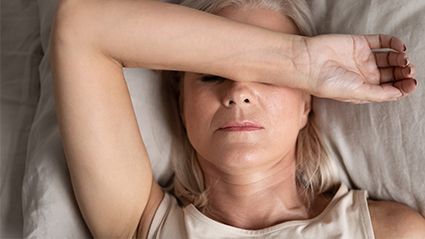
The U.S. Food and Drug Administration on Friday approved the first nonhormonal medication aimed at easing menopause hot flashes.
The new pill, called Veozah (fezolinetant), is from a class of drugs called neurokinin 3 (NK3) receptor antagonists. It targets a specific brain neuron that’s thought to be set off balance as estrogen levels naturally decline during menopause.
“It works by binding to and blocking the activities of the NK3 receptor, which plays a role in the brain’s regulation of body temperature,” the FDA explained in a news release issued Friday.
“Hot flashes as a result of menopause can be a serious physical burden on women and impact their quality of life,” said Dr. Janet Maynard, who directs the Office of Rare Diseases, Pediatrics, Urologic and Reproductive Medicine at the agency’s Center for Drug Evaluation and Research.
“The introduction of a new molecule to treat moderate to severe menopausal hot flashes will provide an additional safe and effective treatment option for women,” she said in the news release.
According to the FDA, over 80% of menopausal women experience sudden, often debilitating hot flashes lasting several minutes that can be accompanied by sweating, flushing and chills.
While estrogen-based hormone replacement therapy has long been used to help ease these symptoms, long-term use has been linked to a heightened risk for breast cancer and stroke.
In addition, “some women who experience hot flashes and have a history of vaginal bleeding, stroke, heart attack, blood clots or liver disease, cannot take hormone therapies,” the FDA explained. “Veozah is not a hormone. It targets the neural activity which causes hot flashes during menopause.”
Women take Veozah once a day as a 45 milligram pill, and if a day is missed users should resume taking Veozah as soon as possible and get back on schedule to help keep hot flashes at bay, the FDA said.
The agency based its approval on the results of two phase 3 clinical trials involving women who averaged 54 years of age. Women first took either Veozah or placebo for 12 weeks — the trial was “blinded,” meaning the women were not told which regimen they were receiving. Then all women were given Veozah for an additional 40 weeks to assess safety.
“The most common side effects of Veozah include abdominal pain, diarrhea, insomnia, back pain, hot flush [flashes],” the agency said.
There was also a risk of elevated hepatic transaminase, or liver injury, so “before using Veozah, patients should have blood work done to test for liver damage or infection,” the FDA said. “While on Veozah, routine bloodwork should be performed every three months for the first nine months of using the medication.”
Veozah is made by Astellas Pharma US, Inc. Speaking with The New York Times, Marci English, a vice president at Astellas, called hot flashes “distracting” and “uncomfortable.”
“It’s something that we kind of managed in silence,” she said. English said Astellas hopes to have Veozah in pharmacies within the next three weeks, and the drug will cost about $550 for a 30-day supply, before any rebates. According to the Times, Astellas said it would begin a support program “to help patients access the medication they were prescribed.”
More information
Find out more about hot flashes at the U.S. National Institute on Aging.
SOURCES: U.S. Food and Drug Administration, news release, May 12, 2023; The New York Times
Source: HealthDay

Leave a Reply